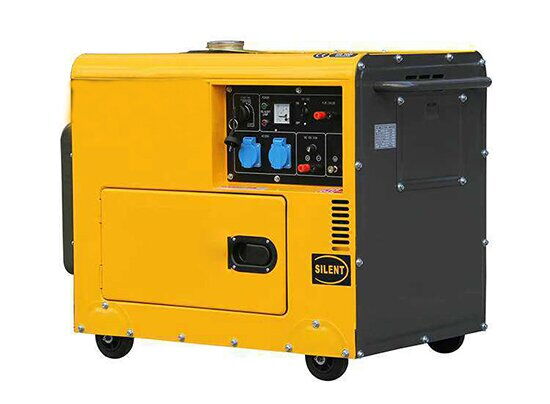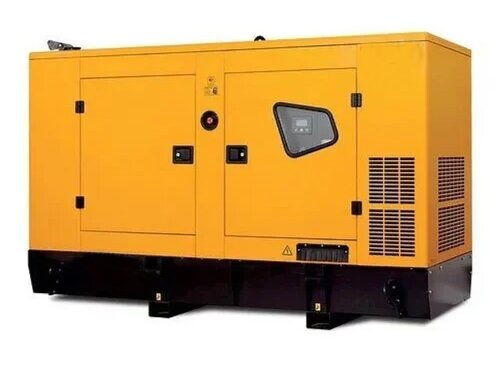Diesel generators are widely used power devices in modern society, found in various locations ranging from residential homes to industrial, commercial, and construction sites. Based on their power output types, diesel generators are primarily classified into two categories: single-phase and three-phase generators. Although both belong to the same category of diesel generators, they differ significantly in terms of power output, working principles, suitable applications, and equipment configurations. Understanding these differences is essential for selecting the appropriate diesel generator. This article provides a detailed comparison of the principles, applications, advantages, disadvantages, and appropriate scenarios for single-phase and three-phase diesel generators to help you make a more informed choice.
A single-phase diesel generator is a common power device typically used in areas with low power requirements. With a simple structure, it meets the needs of small equipment and household usage. Despite its relatively simple working principle, single-phase generators still play an indispensable role in daily life and small-scale commercial fields.

The power output of a single-phase diesel generator is transmitted through three cables: one live wire (L1), one neutral wire (N), and one ground wire (GND). It generates power through the single live wire (L1), with an output voltage usually around 220V. Single-phase generators typically operate with alternating current (AC), where the voltage and current alternate in a set cycle.
The working principle of single-phase generators is relatively simple, making them suitable for applications with low power requirements. Due to their simplicity, cost-effectiveness, and ease of installation and maintenance, they are often the preferred choice for many small-scale equipment and applications.
Single-phase diesel generators are most commonly used in areas with lower power demands, typically with an output range from 1kW to 30kW. Some common applications include:
Household Electricity: In areas with unstable electricity supply or where the grid cannot be accessed, single-phase generators are commonly used to provide daily household power. They are suitable for driving typical household appliances such as lighting, TVs, and air conditioners.
Small Commercial Facilities: For small shops, cafes, and restaurants, which require limited electricity, single-phase generators meet basic power needs.
Outdoor Activities: Camping, outdoor work, and small outdoor events often utilize single-phase generators. Due to their small size, portability, and ability to provide basic power, they are ideal for these settings.
Backup Power in Rural Areas: In rural areas where power supply is insufficient or unstable, single-phase generators serve as backup power sources to ensure essential living requirements.
After understanding the working principle and applications of single-phase diesel generators, let's analyze their advantages and disadvantages to help users make a better decision when selecting a generator.
Simple Structure, Easy Installation: Single-phase generators have a simple structure, making installation, setup, and maintenance easy and cost-effective. They are ideal for budget-limited, small-scale applications.
Lower Cost: Due to their simpler design and components, single-phase generators have a lower initial investment cost, making them suitable for places with low power demands.
Suitable for Small Load Devices: Single-phase generators provide stable power supply for household appliances and small commercial facilities.
Unstable Power Output: The power output of single-phase generators can fluctuate, especially under varying loads. This may negatively impact devices that require stable power supply.
Limited Power Supply: Single-phase generators cannot drive high-power devices and cannot provide three-phase power, thus limiting their use in high-power industrial equipment or large-scale operations.
Higher Risk of Failure: Since a single-phase generator relies on one live wire for power, if this wire fails, the entire power supply will be interrupted, affecting system stability.
Compared to single-phase diesel generators, three-phase diesel generators offer significant advantages in power output and application range. Here, we explore the working principle of three-phase diesel generators and the fields in which they are most applicable.

In contrast to single-phase generators, three-phase diesel generators use three live wires (L1, L2, L3) along with a neutral wire (N) and a ground wire (GND) to provide power. These generators output power through the three live wires simultaneously, with a phase difference in the current waveforms between each wire. This design ensures stable power output, and the fluctuation of three-phase power is minimal.
The output voltage of three-phase generators is typically higher, ranging from 380V to 440V, and they provide a more powerful and stable power output than single-phase generators. Due to their efficient power generation capacity and higher voltage, three-phase generators are widely used in large-scale industrial, commercial, and construction environments.
Three-phase diesel generators typically have larger power output ranges, making them suitable for applications requiring higher power and stable electricity. Some typical applications include:
Industrial Power: Three-phase generators are most commonly used in the industrial sector, where high-power equipment is needed during production processes. They provide stable and efficient power to meet the demands of large-scale operations.
Construction Sites: Large construction sites require power for multiple equipment, and three-phase generators efficiently meet these needs. They can provide enough power for cranes, welding equipment, lighting systems, and more.
Large Commercial Facilities: Hotels, shopping centers, office buildings, and other commercial facilities with high electricity demand rely on three-phase diesel generators to ensure uninterrupted operations.
Hospitals and Data Centers: Equipment in hospitals and data centers have extremely high power demands, and any interruption in power supply can have severe consequences. Three-phase generators, with their high stability and continuous output, are ideal power solutions for these critical sectors.
After reviewing the working principle and applications of three-phase diesel generators, let's examine their advantages and disadvantages, which will help you evaluate whether they suit your needs.
Stable Power Output, Reliable Supply: Since three-phase generators deliver power through three live wires, the power output is stable. Even if one phase fails, the remaining two phases can continue to provide power, ensuring an uninterrupted power supply.
Suitable for High Power Demands: Three-phase generators are capable of providing larger power output, making them suitable for large industrial equipment, commercial facilities, and construction sites that require substantial electricity.
Efficient and Energy-saving: Due to the design characteristics of three-phase power, these generators are more efficient than single-phase generators when providing the same power output, with less energy loss.
Higher Initial Investment: Three-phase generators have a more complex structure, which leads to higher costs. For applications with low power needs, investing in a three-phase generator may result in unnecessary expenses.
More Complex Installation and Maintenance: Due to the more complex system of three-phase generators, installation and maintenance require specialized technical support, which increases maintenance costs and technical requirements.
Having discussed the working principles and advantages of both single-phase and three-phase diesel generators, let's now provide a brief comparison between these two types of generators.
Single-phase Generator: The output voltage is typically 220V (may vary in different regions). Suitable for small power-demand equipment and household appliances.
Three-phase Generator: The output voltage is higher, typically between 380V and 440V. It is ideal for high-power equipment and industrial applications, ensuring stable and efficient power supply.
Single-phase Generator: Suitable for small appliances, household devices, and low-power applications. The power output is generally small and best suited for low-load usage.
Three-phase Generator: Suitable for large industrial equipment, high-power motors, and demanding applications. Three-phase generators offer stable and efficient power output to meet the needs of large-scale operations.
Single-phase Generator: Power output can fluctuate due to reliance on a single live wire, particularly when load changes significantly.
Three-phase Generator: Power output remains stable, as three live wires supply power simultaneously, ensuring consistent electricity even if one phase fails.
Single-phase Generator: Suitable for household power supply, small shops, small construction sites, temporary outdoor activities, and areas with low power demand.
Three-phase Generator: Widely used in large industrial plants, construction sites, hospitals, data centers, large commercial facilities, and other high-power-demand environments.
When selecting a diesel generator, consider the following factors:
Power Requirements: Determine whether you need a single-phase or three-phase generator based on the total power required for your equipment. For low power demand with fewer devices, a single-phase generator is more economical. For large equipment, a three-phase generator is preferable.
Budget: If the initial budget is low, a single-phase generator may be more cost-effective, though consider its limitations in scalability and power stability. If the budget allows for long-term use and potential expansion, a three-phase generator offers better cost-efficiency in the long run.
Application Environment: For home use, mobile devices, or temporary worksites, a single-phase generator is more suitable due to its compact and convenient design. For fixed-location factories or hospitals, prioritize three-phase generators to ensure stable power supply.
Future Scalability: If you plan to increase load-bearing equipment in the future, consider investing in a three-phase generator to avoid the cost of purchasing new equipment later on.
Both single-phase and three-phase diesel generators are common power supply devices, each with its own advantages in terms of power output, structural design, application scenarios, and stability. Single-phase generators, with their simple structure and low cost, are ideal for low-load and low-power applications, while three-phase generators, due to their high efficiency and stability, are more suited for high-power and continuous supply applications. When selecting a generator, assess your actual power needs, usage environment, and potential future expansion to make a comprehensive and informed decision. Rational selection will ensure an efficient, reliable power supply that meets the diverse needs of various sites and industries.
